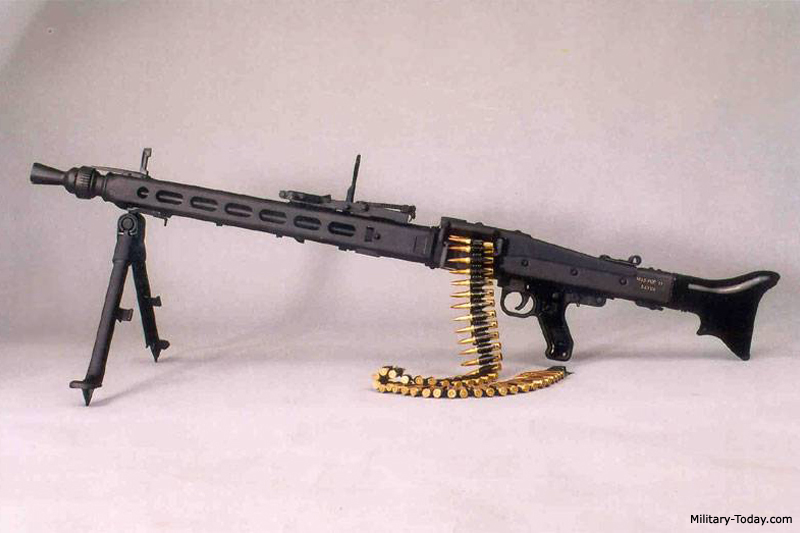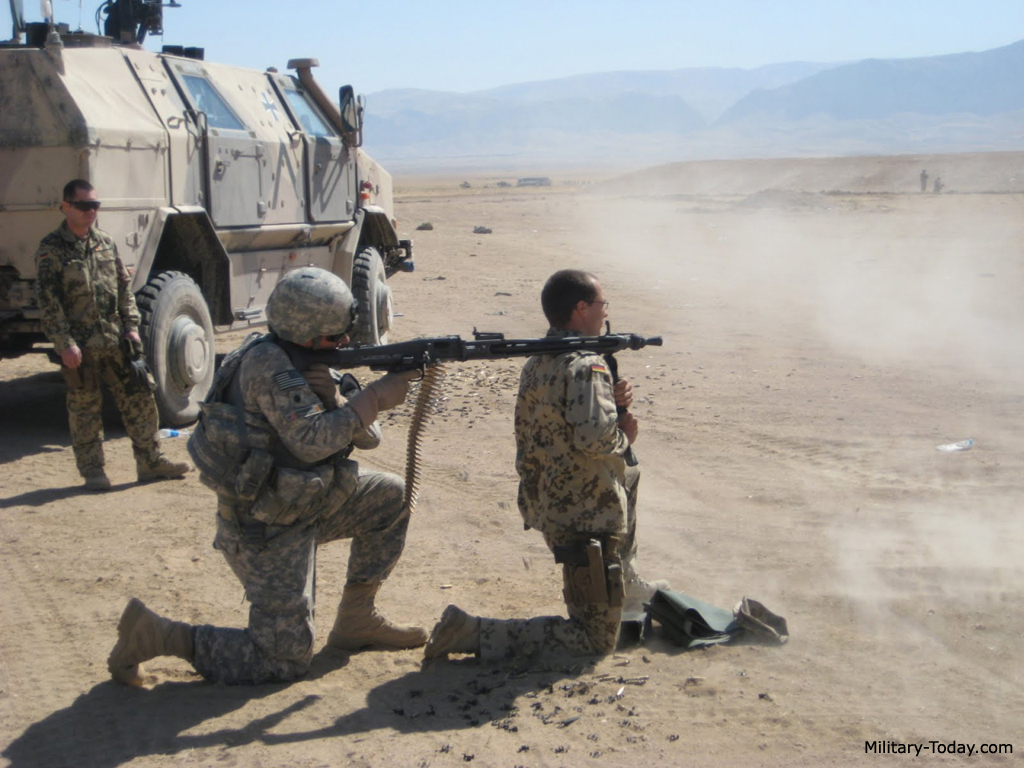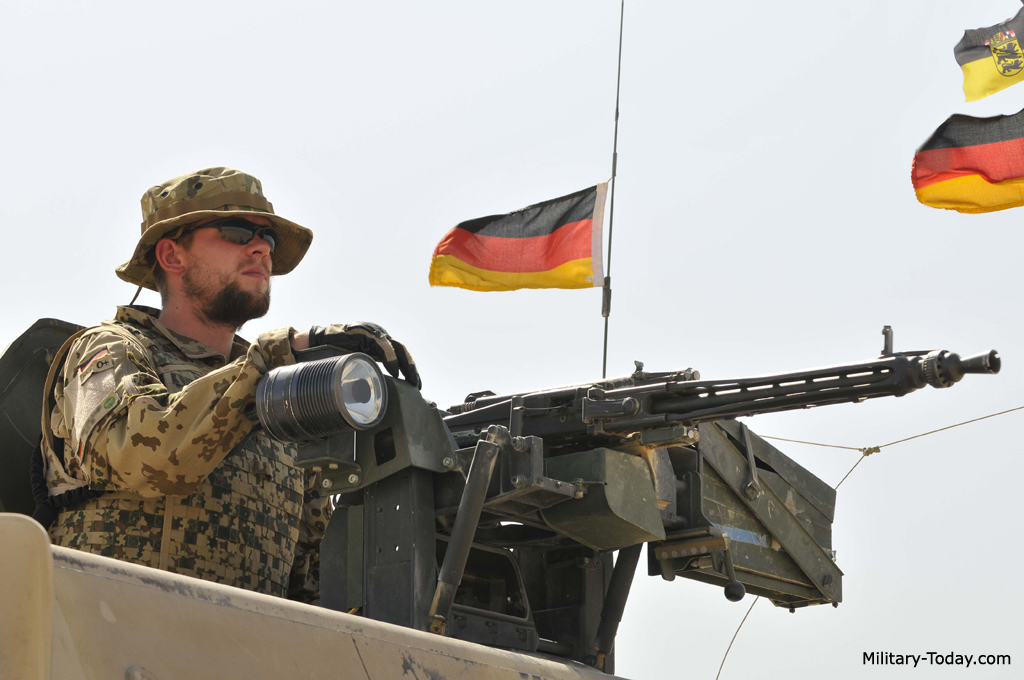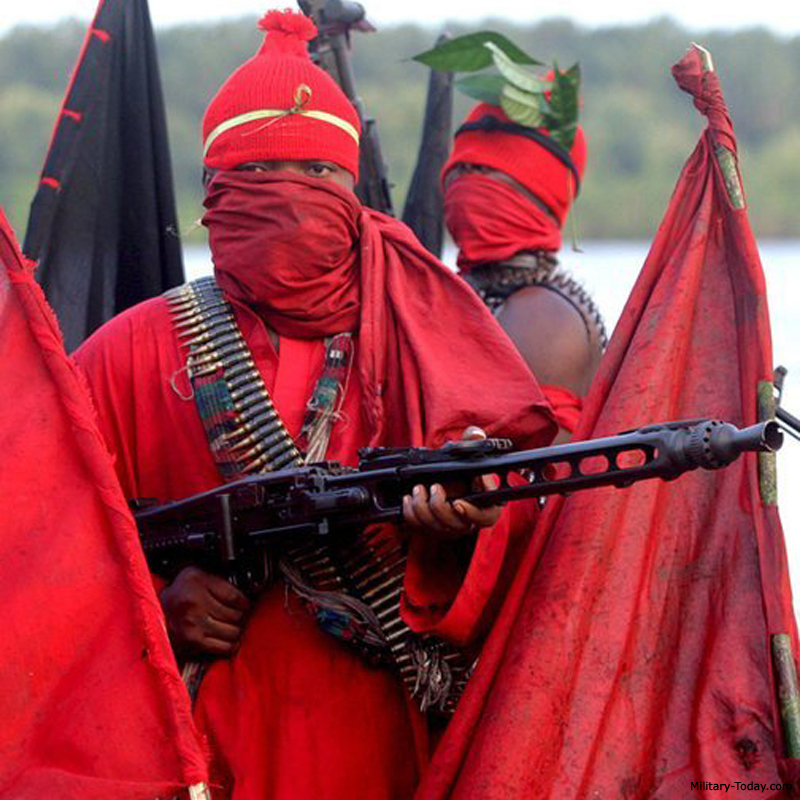Zarvan
ELITE MEMBER

- Joined
- Apr 28, 2011
- Messages
- 54,470
- Reaction score
- 87
- Country
- Location

The MG-3 is one of the most popular and effective machine guns in the world today
Country of origin West Germany
Entered service 1959
Caliber 7.62 x 51 mm NATO
Weight (unloaded) 10.5 kg
Weight (unloaded, on tripod) 27.5 kg
Length 1 225 mm
Barrel length 565 mm
Muzzle velocity 820 m/s
Cyclic rate of fire 1 100 rpm
Practical rate of fire 250 rpm
Magazine capacity 50, 100, 120 or 250 round belts
Sighting range 1 200 m
Range of effective fire 1 200 m
The Rheinmetall MG-3 is one of the most successful machine guns in the world today, and remains in production and widespread service more than 60 years after it was first adopted.
There is little to be said of the MG-3's design or development, as it is essentially just an improved MG-42 re-chambered for 7.62x51 mm NATO round. The MG-42 had been the most innovative machine gun of World War 2, arguably the most successful, and it was one of the most feared weapons in the arsenal of the Axis; for its blistering rate of fire, US troops knew the MG-42 as "Hitler's Buzzsaw", the Russians called it "The Linoleum Ripper", and German troops called it "Hitler's Bone Saw". It had twice the rate of fire of most other machine guns in use at the time, but was still easily controllable, and boasted the first quick-change barrel ever seen on a battlefield. The consensus of historians is that the MG-42 was the best machine gun of World War 2, and there are more than a few of these authorities who still consider it to be the best ever made. After the war, nearly every army in the world wanted surplus MG-42s, or other weapons with many of the same qualities, and it inspired the development of the MAG 58, the PK, the M60, the AAT-52, and countless others.
When the decision was made for West Germany to re-arm in the 1950s, they re-introduced the MG-42. NATO allowed this as an interim measure, but required West Germany to adopt the 7.62x51 mm NATO cartridge as their standard rifle round. Rather than importing a completely new weapon, or developing one from scratch, West Germany simply put the MG-42 back into production in the new 7.62 mm NATO chambering. The resulting weapon went into service in 1958 as the MG-1, which was further reinforced by the MG-2 (MG-42s built in World War 2, that were factory-rebuilt to fire 7.62 mm NATO).
However, even these were stopgaps for a "second-generation" MG-42 with several improvements, whose development was not yet completed by that time. This new weapon was adopted in 1959 as the MG-3. This new weapon greatly impressed the other NATO nations, many of whom adopted it (some very quickly); even the US, the UK, and France trialed the MG-3 in its early days, though ultimately none of these three nations adopted it.
The MG-3 has an unusual "fishtail" shaped buttstock with a buttplate curved inward, the top of which extends backward to rest atop the user's shoulder. The receiver section is long and rectangular, with a distinctive long, shallow gradient on the cover section that slopes toward the buttstock; it is hinged in front, and the entire receiver cover opens to facilitate loading. The weapon is fed by a belt that normally hangs freely from the left side, though a rectangular box or round drum may also be attached. A submachine gun-style pistol grip and trigger group are located underneath the middle of the receiver group. Of course, a simpler way to describe the layout of the MG3 is that it looks almost exactly like the MG-42. The barrel is surrounded by a long, narrow, rectangular, and heavily-ventilated jacket, the right side of which is a panel that swings-open to allow access to the barrel. A folding bipod and conical flash hider are fitted to the end of the jacket.
The receiver, barrel shroud, and bipod of the MG-3 are made of stamped steel, while the barrels are bored from cold rolled steel. The furniture is typically a synthetic polymer, though older examples of the MG-3 (notably the MG-1 and MG-2) have wooden furniture. Interestingly, aside from the barrel, chamber, and action, most components in the MG-3 are interchangeable with the MG-42.
The MG-3 is not a selective-fire weapon; the only fire settings are "safe" and "fire", and effectively producing short bursts or single shots depends solely on the shooter's skill. The safety is a cross-bolt type, which is switched on or off via a button-like switch. The cyclic rate of fire may be altered by installing different bolts and recoil springs, and the conical muzzle brake also doubles as a flash hider and a recoil booster.
The MG3 is short recoil operated and striker-fired, with a roller-locked bolt carrier, and fires from an open bolt. The bolt carrier consists of a bolt head (which includes a spring-loaded casing extractor and ejector) and body, two cylindrical rollers, a wedge-shaped striker sleeve, and a return spring; the striker sleeve locks the bolt in place. Both the barrel and barrel extension recoil when the weapon is fired, which cycle the action by colliding with the bolt carrier and drive it rearwards, retracting the striker sleeve (which unlocks the bolt), and camming the rollers in and out of their sockets via fixed cams, which also unlocks the bolt head. The bolt carrier and bolt continue to travel rearward, steadied by a set of fixed guides, while the barrel and barrel extension return to battery. As the bolt returns, the breech camming surfaces and the surfaces of the striker sleeve force the rollers outward, locking the bolt head securely into the barrel extension. Spent brass is ejected from the weapon when the ejector strikes the buffer head, which drives the ejector bar forward and strikes the ejector pin. The pin pushes the casing (still held at its base by the extractor system) downward, forcing it out of the weapon through the ejection chute underneath the action.
The roller-locking mechanism was an especially important innovation of the preceding MG-42, and was the sole reason that it was manageable with such a high rate of fire (to reiterate, most machine guns in World War 2 had half the MG-42's rate of fire). As with the delayed roller used in the later CETME, G3, and SG 510 rifles, a side effect of the roller locking system was to eliminate most of the weapon's oscillation and muzzle rise, which enabled gunners to send a tremendous amount of bullets down-range with reasonable accuracy.
The MG-3's barrel is integrated directly into the barrel breech. It is chrome-lined, 565 mm long, and employs conventional groove-and-land rifling (though polygonal-rifled barrels have also been developed for this weapon) with 4 grooves in a 1:305 mm twist. During sustained high rated of fire, it is essential to replace the barrel at regular intervals of several-hundred rounds fired, in order to maintain accuracy and safe operation. However, replacing the MG-3's barrel is an exceptionally simple affair, and is achieved by simply cocking the weapon, releasing the catch for the barrel shroud which causes the right side to swing open, and the barrel itself is then swung-out through the right side and removed by elevating or canting the weapon. Replacing the barrel is basically the same procedure in reverse. Expended barrels removed immediately after extended cyclical fire are dangerously hot --- sometimes approaching white-hot temperatures --- and must only be handled and discarded using authorized equipment and methods. Each barrel weighs 1.8 kg.
The MG-3 accepts ammunition from continuous-link DM1 belts, disintegrating-link DM6 belts, or similar belts (such as the disintegrating-link M13), but it will not feed traditional cloth belts. These include 50-round, 100-round, 120-round, and 250-round belts, depending on the type in question. It cannot feed ammunition from rifle magazines and drums, although H&K developed a drum for the MG-3 that can hold a belt with up to 120 rounds. The DM2 steel ammunition box may also be attached to the MG-3; this box holds DM1 belts with up to 250 rounds in total.
The sights consist of a front barleycorn and a rear V-notch, as well as a flip-up anti-aircraft sight. The rear sight has a 430 mm radius, and is adjustable for windage, and ranges of 200 m to 1 200 m in 100 m increments.
Bipods are fitted to all MG-3s, and are attached to the front of the barrel shroud. The MG-3 is also one of the few machine guns in widespread service that is commonly fired from a tripod. The standard model used by the German armed forces is the Feldlafette ("Field Tripod"), which also includes a Zielfernrohr 4×24 telescopic sight.
The number of users of the MG-3 is even greater than the number of bullets it can fire within the space of a second, and over 30 nations have operated it. These include Argentina, Australia, Austria, Bangladesh, Brazil, Canada, Cape Verde, Chile, Cyprus, Denmark, Estonia, Finland, Germany, Ghana, Greece, Iceland, Iran, Italy, Lithuania, Macedonia, Mexico, Morocco, Myanmar, Norway, Pakistan, Poland, Portugal, Sao Tome and Principe, Saudi Arabia, Spain, Sudan, Sweden, Thailand, Togo, and Turkey. Most of these still use the MG-3, although several (Germany included) are beginning to phase them out of service.
In addition to being manufactured in Germany by Rheinmettal, the MG-3 has also been manufactured under license by Steyr in Austria, EBO in Greece, in Italy by Beretta, Franchi, and Whitehead Moto-Fides, in Mexico by SEDENA, in Myanmar by Ka Pa Sa, in Iran by AMIG, in Pakistan by POF, in Spain by Santa Barbara, in Sudan by MIC, and in Turkey by MKEK. A new MG-3 costs about $3 000.
Given its numbers, distribution, and long operational history, it should come as no surprise that the MG-3 has been used in numerous armed conflicts across the world. These include many recent conflicts, such as the Iran-Iraq War, and ongoing conflicts to include the Turkey-PKK conflict, the Afghan War, and the Yemeni Civil War. Given the MG-3's results thus far, it would hardly be surprising if this weapon from 1959 were still in service in some capacity by 2059.
Variants
MG-42: Progenitor of the MG-3, and almost identical save for its 7.92x57 mm Mauser chambering. The MG-42 was used in large numbers by many nations across the world after World War 2, but it appears that this venerable weapon is no longer in service.
M53: Essentially a cousin of the MG-3, the M53 is a Yugoslav copy of the MG-42. However, its rate of fire has been reduced, and no anti-aircraft sights were fitted.
MG-1: Essentially the early production model of the MG-3, the MG-1 was simply an MG-42 re-chambered in 7.62x51 mm NATO. Its original designation was MG42/59.
MG-2: These were wartime MG-42s converted to fire 7.62mm NATO, essentially making them identical to the MG-1.
MG-3: An MG-1 with several improvements (notably its new anti-aircraft sights), and the definitive production model of the series.
MG-3E: Reduced-weight version of the MG-3.
MG-3A1: MG-3 variant developed especially for use on armored vehicles.
MG-3KWS: Improved MG-3 developed by Rheinmetall and Tactics Group as an interim weapon, until the HK 121 machine gun becomes available in quantity.
Ksp m/94: Licensed Swedish-built MG-3. The Ksp m/94 is used mainly on the Stridsvagn 122 main battle tank.
Karar: Licensed Sudanese-built MG-3.
7.62 KK MG-3: Licensed Finnish-built MG-3.
MA 15: Licensed Myanmar-produced MG-3.
MG-58: Another "cousin" of the MG-3, the MG-58 is an Austrian copy of the MG-42, re-chambered in 7.62x51 mm NATO.
MG 74: Austrian general-purpose machine gun based on the MG-42, with a new 7.62x51 mm NATO chambering, a heavier bolt carrier that reduced the rate of fire to 850 rpm, and composite furniture to reduce its overall weight. It replaced the MG-42 in Austrian service.
m/960: Licensed Portuguese-built MG-3.
RMG 7.62: Triple-barrel MG-3 developed by Rheinmetall Defence as a vehicle-mounted, crew-served weapon.
MG-14Z: Twin-barrel MG-3 developed by Tactics Group GmbH as a vehicle-mounted, crew-served weapon.
Rheinmetall MG3
General Purpose Machine Gun

Rheinmetall MG3
General Purpose Machine Gun

Rheinmetall MG3
General Purpose Machine Gun

Rheinmetall MG3
General Purpose Machine Gun

Rheinmetall MG3
General Purpose Machine Gun

Rheinmetall MG3
General Purpose Machine Gun

Rheinmetall MG3
General Purpose Machine Gun












